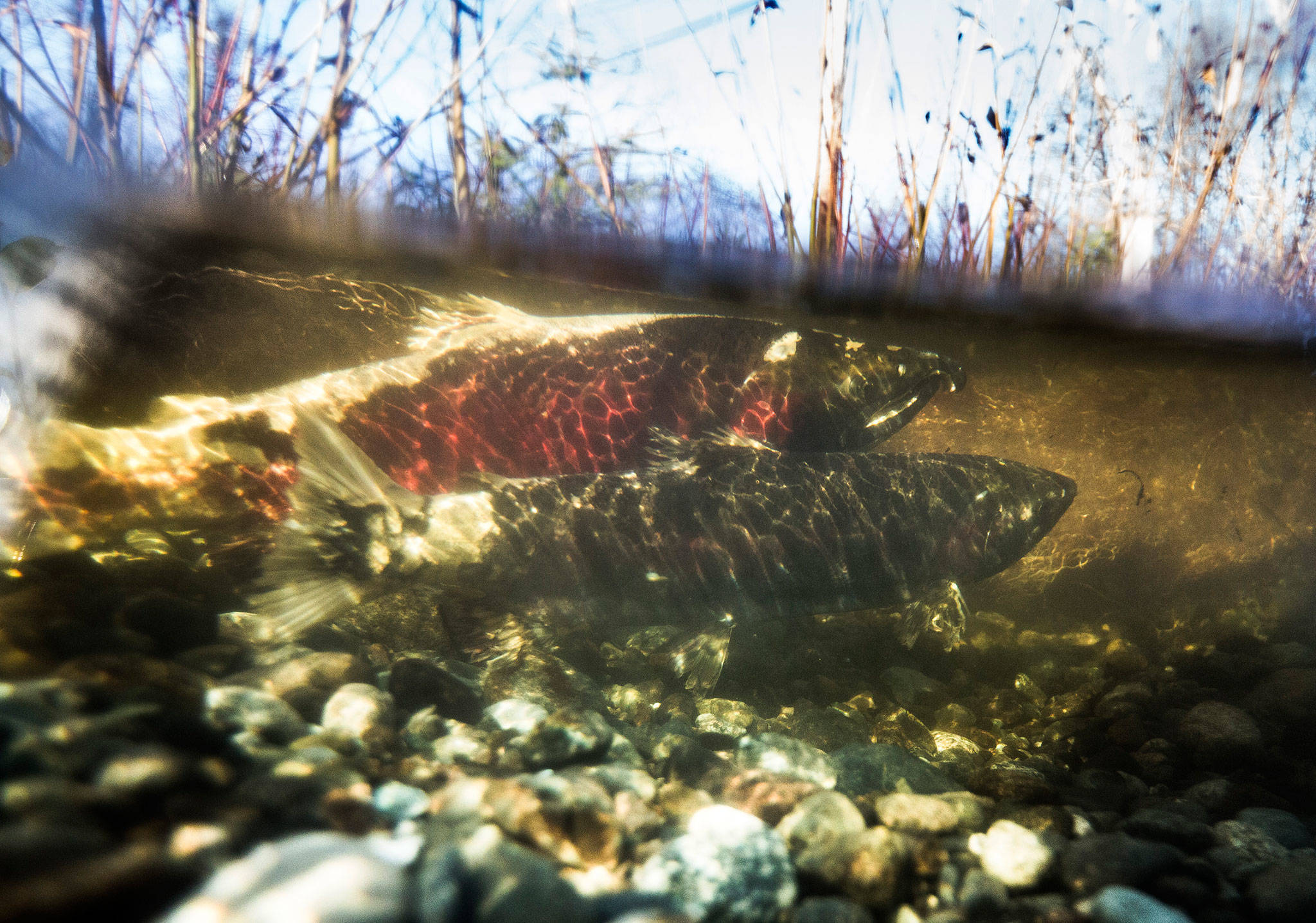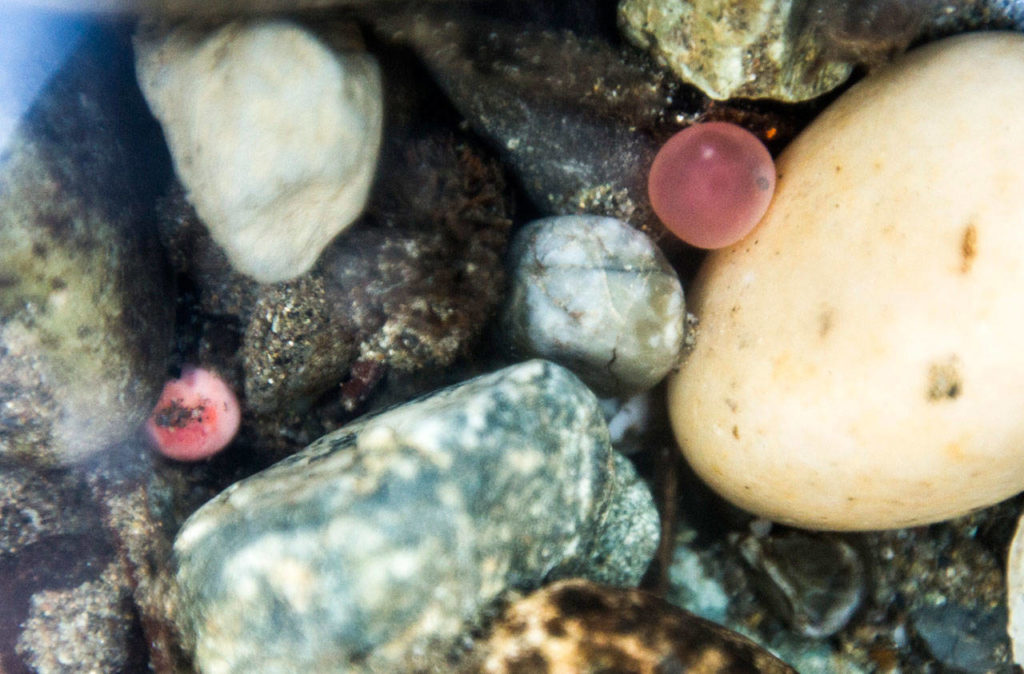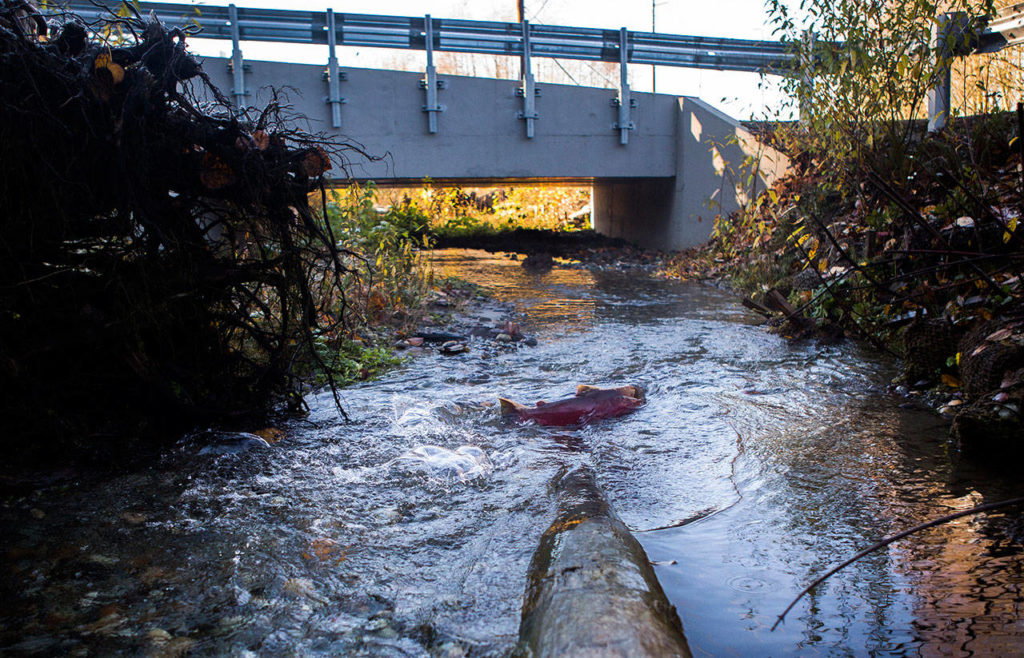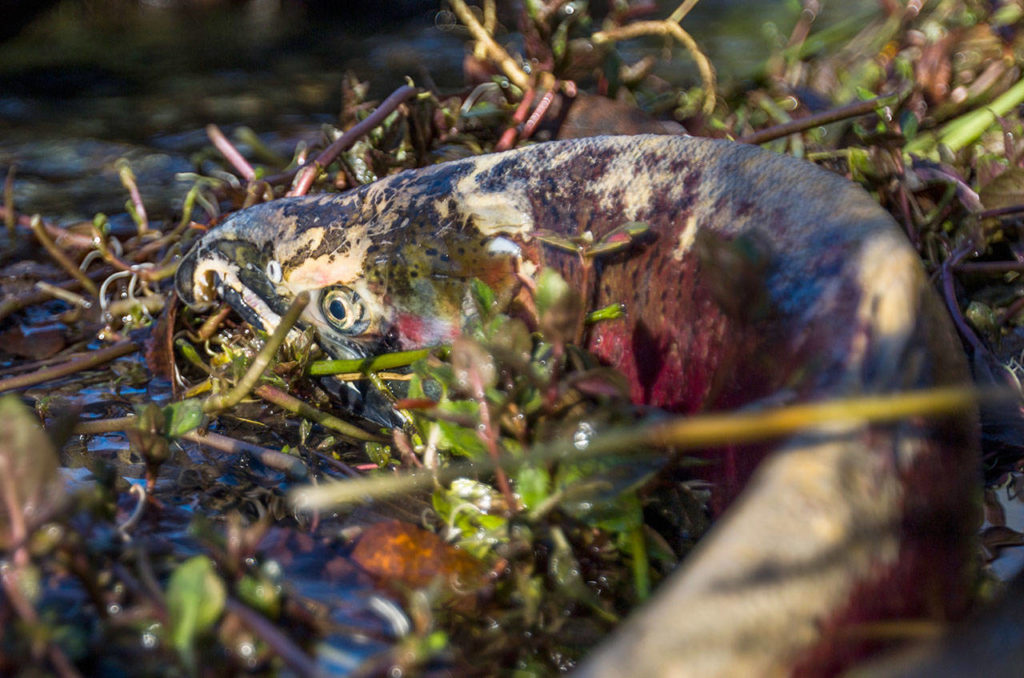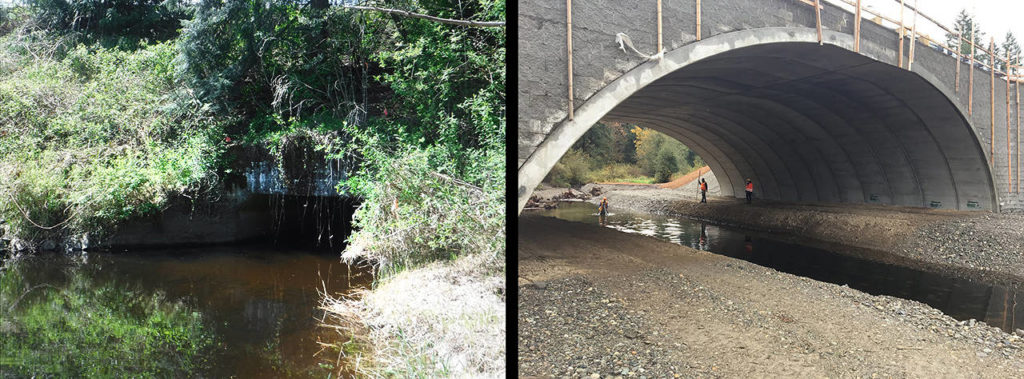ARLINGTON — The fish traveled 10 miles from the sea to reach this point, and it wasn’t easy.
As soon as the water lost its saltiness, she had stopped eating. Instead, her body drew energy from fat storage, muscles, organs — all except the organs that help her reproduce. Because that was the only goal now.
She passed through a city, wended between thousands of back yards, zigzagged through irrigation ditches. Along the way, she whipped her body in great leaps, pushing through the strong flows coming out of narrow culverts under roads and railroad tracks.
Now she was here.
The coho meandered through the shallow creek as cool air brushed over her dorsal fin. The water was clear, and stretched on and on. Soon, she leaned over and swished her tail to form her own redd, or nest.
Nearby, a pair of males butted each other with hooked noses, or kypes, to compete for the right to fertilize her eggs with their milt. The winning suitor swam alongside her in courtship.
On the banks, the bodies of coho that had finished this final work lay still.
Up above, pickups and school buses streamed past on a busy state highway. Neither people nor fish seemed to notice each other. They each followed the paths laid before them.
The trill of a bird was met by the horn blast of a freight train.
This is the site of one of the state’s latest fish passage projects. A small portion of Edgecomb Creek now runs along the southern edge of Highway 531 east of 67th Avenue NE. Coho were still spawning here early last week.
It’s the first time in recent memory that spawning salmon have had free access to the most inland — and most habitable — portions of Edgecomb Creek.
Edgecomb Creek used to make a U-turn underneath the highway, in one culvert and out a smaller one with an impassable log weir in between. The Washington State Department of Transportation last year bought out a property owner, tore down the house, then rerouted the creek to the site south of the highway. With backhoes and dump trucks full of gravel, they set out to create a natural habitat.
But the key piece was all concrete — a 16-by-6-foot box culvert, installed under a nearby driveway — to link the rerouted stretch to the rest of the creek as it continues east. Redd-friendly gravel and a stream-bed mix were layered over the bottom of the culvert to mimic the creek. To the fish eye, there’s no break.
What had been a mere 100 meters of reachable habitat now stretches a mile.
In late November, the rerouted creek teemed with spawning coho.
“This entire stretch was one continuous redd,” said Rob Woeck, a WSDOT biologist. “It continued head-to-tail fish. It gives you goosebumps to see.”
The project is among hundreds that aim to replace about 1,000 state-owned culverts that pose a barrier to fish passage. The work is to comply with a 2013 U.S. District Court for Western Washington ruling over historical tribal fishing rights. The state must restore access to 90 percent of the most significant habitat areas by 2030. About 415 remain to meet that mandate.
In Snohomish County, 138 known barriers are on the to-do list. Nine have been fixed.
Edgecomb Creek is one of the success stories.
But the site also highlights the limits of the projects, and points to larger challenges ahead.
Barriers remain
Coho are the jocks of the salmon species. If any adult salmon were going to make it to Edgecomb Creek, it was them.
Chum used to be found here too. You don’t see them now. They’ve mostly gone the way of the black bear, whose claw marks on nearby trees are bleached with age.
“Chum have a hard time getting through any kind of barrier. They’re the least athletic,” Woeck said.
And the latest improvements won’t change that.
That’s because there are at least six more partial barriers to fish passage on the route from the mouth of the Snohomish River to these breeding grounds, based on the Washington Department of Fish and Wildlife’s Salmonscape map and other observations. These culverts are owned by local governments and private landowners, including BNSF.
But none are state-owned. So none are required by the court order to be fixed.
You don’t have to look far. Just across 67th Avenue NE is a narrow pipe running under BNSF railroad tracks from farm fields.
“After a big rain, it’s like someone’s standing there with a big fire hose,” Woeck said.
Not even coho can get through at that point.
Big price tags
At $3 million, Edgecomb Creek fits the average cost for fish passage projects so far. More complicated and more costly projects are to come.
The state estimates it will cost about $3.6 billion to repair all currently identified barriers that fall under the injunction. Costs often are tied to the level of traffic impacts. Some of the target barriers run beneath I-90 and I-5.
Edgecomb Creek highlights how state planners are approaching the challenges on a smaller scale.
Rerouting streams to avoid highway crossings is preferred. And in this case it also was cheaper to buy out a willing property owner than to close Highway 531 for weeks to replace the existing culverts, Woeck said. Bonus for drivers: avoiding a major road closure.
The project also highlighted the level of coordination needed. Representatives of various agencies — from the Tulalip Tribes to the U.S. Army Corps of Engineers — were brought to the site for a firsthand look. Fish passage projects must often be done during short time windows. When the Edgecomb Creek project faced a series of delays, the relationships built early on helped speed permitting, Woeck said.
There’s also the issue of picking the right solution.
A cheaper box culvert works for the short driveway at the Edgecomb Creek site. But in other cases, a box culvert could just repeat past mistakes. Given enough time, a creek bottom can drop, but a culvert bottom won’t.
Edgecomb Creek had already experienced this solution-turned-problem. The log weir was installed in 1996 to help salmon access the smaller upstream culvert. As the creek bed dropped, the weir became an even bigger barrier than the culvert.
Big closures
Making the right choice now to avoid bigger bills down the road could mean building more bottomless and wider solutions: bridges. That will have a more dramatic effect on the landscape — and drivers’ nerves.
A recent example was built this summer at Little Pilchuck Creek under Highway 92 in Lake Stevens. The $6 million project replaced a 12-foot wide box culvert with a 60-foot buried bridge. The upgrade expands access to nearly 30 miles of habitat upstream.
The project required several road closures, including one that lasted nearly two weeks, diverting 12,000 vehicles onto other roadways each day.
Some area residents expressed disbelief to a contractor when they learned of the plans, Woeck said. Salmon? There’s no salmon here. But before starting construction, the state relocated 6,000 young coho from the area.
“The outdoor cult in the Pacific Northwest, whether people are transplants to the area or have been here forever — people appreciate and enjoy having salmon in their back yard,” Woeck said.
They just may not realize it’s literally in their back yard.
“If you have water in a stream in winter, it used to have salmon whether it has it now or not,” he said.
Planning for the future
Salmon species like coho can take three years to return to spawn. That means it will take six years to start measuring the impact of projects like Edgecomb Creek.
What will happen in this rapidly growing area in that time?
Just across the highway, construction fencing prepares for a new condominium development. Plans to widen Highway 531 continue to march east. Farmland persists to the west, but for how long?
“When this gets developed, what happens?” Woeck said. “Will any of this matter?”
“The functionality of these (habitats) can continue to spawn all these coho forever, so long as we protect it as we develop intelligently,” he said.
For now, workers have already been back to Edgecomb Creek to add stakes, saplings and biodegradable bags of stream rock to keep a wandering creek from encroaching on a fixed road.
A dump truck rushes past, causing newly planted willows to sway. A shrub catches a plastic bag. A guardrail shows signs of a recent collision.
Down below, hundreds of thousands of tiny eggs lay in underwater nests. In the spring, coho fry will emerge from the gravel and start exploring a habitat that is expanding too.
Melissa Slager: streetsmarts@heraldnet.com, 425-339-3432.
Talk to us
> Give us your news tips.
> Send us a letter to the editor.
> More Herald contact information.
